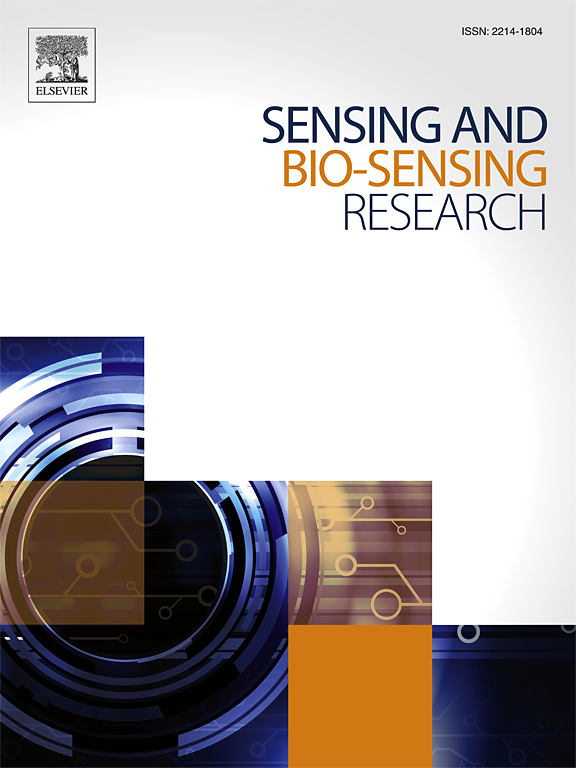基于CRISPR-Cas12a的游离细胞DNA EGFR基因突变检测在非小细胞肺癌(NSCLC)早期诊断中的应用
IF 5.4
Q1 CHEMISTRY, ANALYTICAL
引用次数: 0
摘要
检测循环无细胞DNA (cfDNA)中的EGFR突变对于非小细胞肺癌(NSCLC)的个性化治疗和实时监测至关重要,特别是当组织活检无法选择时。识别cfDNA中这些突变的传统方法是有限的,并且通常需要大量的实验室设置。CRISPR-Cas系统,特别是DETECTR方法中使用的Cas12a变体,为生物液体中高度敏感和特异性突变检测提供了一种开创性的方法,显著提高了诊断能力。在这项研究中,我们提出了一种新的、快速的、精确的方法,将DNA扩增的重组酶聚合酶扩增(RPA)与CRISPR-Cas12a荧光分析相结合,检测EGFR突变。该技术实现了原子级的灵敏度,没有交叉反应性,在37°C附近起作用,并在一小时内提供结果,非常适合在精确肿瘤学的临床应用。为了进一步提高其在护理点诊断中的实用性,我们将Cas12a与基于侧流的检测结合起来,实现了单拷贝检测灵敏度。在一项涉及57例NSCLC患者样本的临床试验中,该方法成功识别出EGFR突变,其结果与PCR获得的结果一致。基于CRISPR-Cas12a的横向流动试验显示出异常的敏感性和特异性,甚至可以在单个试纸上同时检测到双重突变。这些结果将CRISPR-Cas12a检测系统定位为PCR的一种直接、高灵敏度的替代方法,在检测cfDNA突变方面具有重大的应用潜力。本文章由计算机程序翻译,如有差异,请以英文原文为准。
CRISPR-Cas12a based detection of EGFR gene mutation in cell free DNA for early diagnosis of Non-Small Cell Lung Cancer (NSCLC)
Detecting EGFR mutations in circulating cell-free DNA (cfDNA) is essential for personalizing treatment and real-time monitoring of non-small cell lung cancer (NSCLC), especially when tissue biopsies are not an option. Conventional methods for identifying these mutations in cfDNA are limited and often require extensive laboratory set-up. The CRISPR-Cas system, notably the Cas12a variant used in the DETECTR method, presents a groundbreaking approach for highly sensitive and specific mutation detection in biological fluids, significantly advancing diagnostic capabilities. In this study, we present a novel, rapid, and precise method combining Recombinase Polymerase Amplification (RPA) for DNA amplification with a CRISPR-Cas12a fluorescence assay to detect EGFR mutations. This technique achieves attomole-level sensitivity without cross-reactivity, functions near 37°C, and delivers results within an hour, making it highly suitable for clinical applications in precision oncology. To further enhance its utility for point-of-care diagnostics, we integrated Cas12a with lateral flow-based detection, achieving single-copy detection sensitivity. In a clinical trial involving 57 NSCLC patient samples, this method successfully identified EGFR mutations, with results consistent with those obtained via PCR. The CRISPR-Cas12a based lateral flow assay demonstrated exceptional sensitivity and specificity, even detecting dual mutations simultaneously on a single test strip. These results position the CRISPR-Cas12a detection system as a straightforward, highly sensitive alternative to PCR, with significant potential for point-of-care applications in detecting cfDNA mutations.
求助全文
通过发布文献求助,成功后即可免费获取论文全文。
去求助
来源期刊

Sensing and Bio-Sensing Research
Engineering-Electrical and Electronic Engineering
CiteScore
10.70
自引率
3.80%
发文量
68
审稿时长
87 days
期刊介绍:
Sensing and Bio-Sensing Research is an open access journal dedicated to the research, design, development, and application of bio-sensing and sensing technologies. The editors will accept research papers, reviews, field trials, and validation studies that are of significant relevance. These submissions should describe new concepts, enhance understanding of the field, or offer insights into the practical application, manufacturing, and commercialization of bio-sensing and sensing technologies.
The journal covers a wide range of topics, including sensing principles and mechanisms, new materials development for transducers and recognition components, fabrication technology, and various types of sensors such as optical, electrochemical, mass-sensitive, gas, biosensors, and more. It also includes environmental, process control, and biomedical applications, signal processing, chemometrics, optoelectronic, mechanical, thermal, and magnetic sensors, as well as interface electronics. Additionally, it covers sensor systems and applications, µTAS (Micro Total Analysis Systems), development of solid-state devices for transducing physical signals, and analytical devices incorporating biological materials.
 求助内容:
求助内容: 应助结果提醒方式:
应助结果提醒方式:


